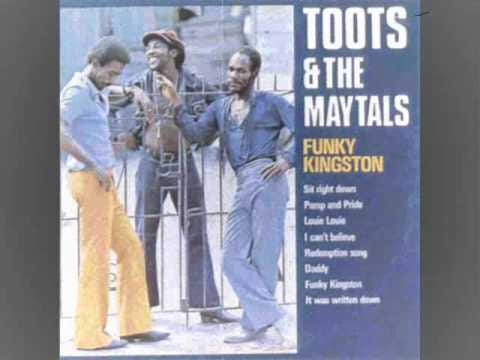key: D blues
mode: D F G Ab A C
melody: S L d mə f s
form: strophic with interlude and coda
meter: duple
English function names: tonic subdominant
Tagg (modified): home counterpoise (away)
Riemann: T7 S7
Scale degrees: I7 IV7
Chords: D7 G7 D7 G7
|:/ / / / |/ / / / :| loopReggay, raggay, reggae… All the spellings. Reggae was originally a dance; Toots was the first to name check it in a song.
Ever since I wrote about Achy Breaky Heart, I have been using a solfege syllable I made up to represent the "blues third" — that third above the tonic that is less of a fixed frequency and more of a spectrum or range between a minor third and a major third and including every frequency in between the two. For those less familiar with intervals, we are talking about the the second scale degree in a theoretical blues scale — That F up there under "mode" could be an F# or it could be something in between F and F#.1 You'll see the solfege syllable up there under "melody" with the schwa. I realized that since then, I haven't been re-explaining2 it every time, which may be causing confusion to new readers, may be aggravating to purists, and every frequency in between the two.
Sometimes people, when they sing the blues, do hit a minor third or major third square on. Certainly if you are playing the piano, you don't have much of a choice. But even singers will sing a veritable minor third or major third in the blues. Often — and you hear Mr. Toots do it in this song — a singer will slide from the lower end of the spectrum to the higher end of the spectrum, possibly never hitting either pitch exactly. And that's when it starts to be a bit silly to try and nail down an exact solfege syllable; either one you choose would be wrong. And every singer would do it differently. Even the same singer will change it up every performance, sometimes higher, sometimes lower, sometimes sliding. That's why I felt having something that was not mi or me, something that was not sharp, flat, or natural, could be quite useful.
And the schwa seemed like the perfect symbol for that sound (although not the greatest vowel for singing anything sustained).3 The neutral third gets the neutral vowel, remembering that the neutral third is not just one fixed pitch, but a tiny range of many possibilities. We would do well to have a symbol in staff notation for this pitch, too. Anthony Braxton uses a star to represent a choice for the player — one could play the note sharp, flat, or natural. This would be a nice, easy symbol to use for blue notes, too, but I wouldn't want to swipe from Mr. Braxton. Something similar, however, could be just the trick. Alternately, we have been playing and notating blues for so long now, it may just be performance practice. We notate a major third, but know that we have a choice of what pitch to actually play at that moment.
This is a song that could be given a new lease on life in the elementary classroom. It's got call-and-response, it's not too hard to sing, you can incorporate an historical lesson on dance, you can improvise over it — a good time plus education. And don't forget to go all out on those la-la-las, just like Toots. Pair it up with Feel Like Jumping and Day-O and you have the beginnings of a Jamaican unit. Win-win, I say.
We could say the same to some extent about the Ab and A, too, but those I find are often played more discretely.
reëxplaining, for you New Yorker readers
This is the vowel sound, that in English morphology is represented by every vowel:
a – comma, atlas, salad, alphabet, amount, thousand
e – elephant, carpet, taken, telephone, item, event, prophet, destroy
i – cousin, animal, pencil, easily, accident, confidence, promise
o – carrot, astronaut, bottom, dinosaur, offend, ribbon, phantom
u – rhombus, upon, supply, medium
y – vinyl, syringe
…which may explain many spelling issues one sees out in the wild. Examples from https://phonicshero.com/schwa/ .



